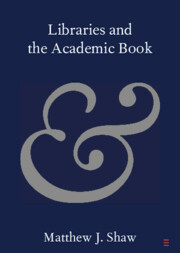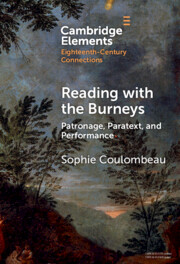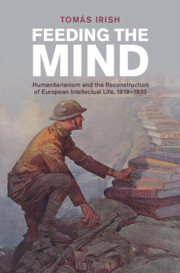Refine search
Actions for selected content:
57 results
10 - Texts
- from Part II - Targets
-
-
- Book:
- The Cambridge Companion to the Spanish Inquisition
- Published online:
- 04 December 2025
- Print publication:
- 18 December 2025, pp 231-254
-
- Chapter
- Export citation
Chapter 1 - Bookish Histories, 1780–1815
-
- Book:
- Irish Romanticism
- Published online:
- 27 November 2025
- Print publication:
- 11 December 2025, pp 26-74
-
- Chapter
- Export citation
Chapter 26 - Libraries and librarians: At home with HASS
- from Part VI - Community and global connections
-
-
- Book:
- Making Humanities and Social Sciences Come Alive
- Published online:
- 02 August 2025
- Print publication:
- 14 August 2025, pp 440-453
-
- Chapter
- Export citation
The Interview: Louis Coiffait-Gunn
-
- Journal:
- Legal Information Management / Volume 25 / Issue 2 / June 2025
- Published online by Cambridge University Press:
- 29 August 2025, pp. 73-78
- Print publication:
- June 2025
-
- Article
- Export citation
3 - Unsettling Foundations
-
- Book:
- Itinerant Belonging
- Published online:
- 10 April 2025
- Print publication:
- 17 April 2025, pp 116-147
-
- Chapter
- Export citation
22 - Books, Libraries, and Texts
- from Part IV - Education, Culture, Arts
-
-
- Book:
- The Cambridge History of the Papacy
- Published online:
- 28 February 2025
- Print publication:
- 20 March 2025, pp 628-655
-
- Chapter
- Export citation
21 - Papal Patronage and the Reception of Classicism in Medieval Rome
- from Part IV - Education, Culture, Arts
-
-
- Book:
- The Cambridge History of the Papacy
- Published online:
- 28 February 2025
- Print publication:
- 20 March 2025, pp 601-627
-
- Chapter
- Export citation

Libraries and the Academic Book
-
- Published online:
- 01 December 2024
- Print publication:
- 12 December 2024
-
- Element
- Export citation
Chapter 7 - Libraries
- from Part II - Social, Cultural, and Intellectual Contexts
-
-
- Book:
- Oliver Goldsmith in Context
- Published online:
- 28 November 2024
- Print publication:
- 07 November 2024, pp 56-63
-
- Chapter
- Export citation
Publishing the Public Humanities
- Part of
-
- Journal:
- Public Humanities / Volume 1 / 2025
- Published online by Cambridge University Press:
- 04 November 2024, e14
-
- Article
-
- You have access
- Open access
- HTML
- Export citation
The Library of the Honorable Society of King's Inns
-
- Journal:
- Legal Information Management / Volume 24 / Issue 3 / September 2024
- Published online by Cambridge University Press:
- 22 January 2025, pp. 143-152
- Print publication:
- September 2024
-
- Article
- Export citation
Chapter 2 - Libraries and Archives
-
- Book:
- History in Flames
- Published online:
- 22 August 2024
- Print publication:
- 22 August 2024, pp 18-37
-
- Chapter
- Export citation
Chapter 10 - Chartres, 26 May 1944: The Municipal Library
-
- Book:
- History in Flames
- Published online:
- 22 August 2024
- Print publication:
- 22 August 2024, pp 155-178
-
- Chapter
- Export citation

Reading with the Burneys
- Patronage, Paratext, and Performance
-
- Published online:
- 30 May 2024
- Print publication:
- 27 June 2024
-
- Element
-
- You have access
- Open access
- HTML
- Export citation
CITRO OR CEDRO REFICIT? ON AN EMENDATION TO A FRAGMENT OF VARRO'S DE BIBLIOTHECIS (FR. 54 GRF FUNAIOLI)
-
- Journal:
- The Classical Quarterly / Volume 74 / Issue 1 / May 2024
- Published online by Cambridge University Press:
- 19 April 2024, pp. 340-343
- Print publication:
- May 2024
-
- Article
-
- You have access
- Open access
- HTML
- Export citation

Feeding the Mind
- Humanitarianism and the Reconstruction of European Intellectual Life, 1919–1933
-
- Published online:
- 07 October 2023
- Print publication:
- 05 October 2023
3 - An Ibadi Library in Cairo
-
- Book:
- The Ottoman Ibadis of Cairo
- Published online:
- 21 September 2023
- Print publication:
- 05 October 2023, pp 77-103
-
- Chapter
- Export citation
Conclusion
- from Part III - Inventing Settler Science
-
- Book:
- The Antipodean Laboratory
- Published online:
- 21 September 2023
- Print publication:
- 05 October 2023, pp 247-259
-
- Chapter
- Export citation
5 - Books and Buildings
-
- Book:
- Feeding the Mind
- Published online:
- 07 October 2023
- Print publication:
- 05 October 2023, pp 155-190
-
- Chapter
- Export citation
6 - Sālim Bin Yaʿqūb
-
- Book:
- The Ottoman Ibadis of Cairo
- Published online:
- 21 September 2023
- Print publication:
- 05 October 2023, pp 172-198
-
- Chapter
- Export citation
